Learn: Buying Diamonds > Fancy Coloured Diamonds
Introduction
Fluorescence and Complimentary Colours
Grading Report Terminology
Fancy Coloured Diamond Values
What Causes Colour In Diamonds
Colour Accuracy From Photos
Dark Zones
Colour Science
Cutting Fancy Shape Diamonds
Setting Fancy Shape Diamonds
Fancy Colour
Myths & Facts
1. Bright Pink describes the best pink diamonds:
It’s more complex. ‘Bright’ is a combination of two color terms, saturation, and tone. You need both to describe a colour, as well as a third hue.
2. The best cut quality makes coloured diamonds look better:
It is almost the opposite. The best cut reduces a FCD’s potential colour and can make the stone appear darker.
3. Fluorescence lowers FCD prices:
Yes and no. Blue fluorescence in a yellow diamond makes it paler in daylight. But yellow fluorescence can enhance its colour.
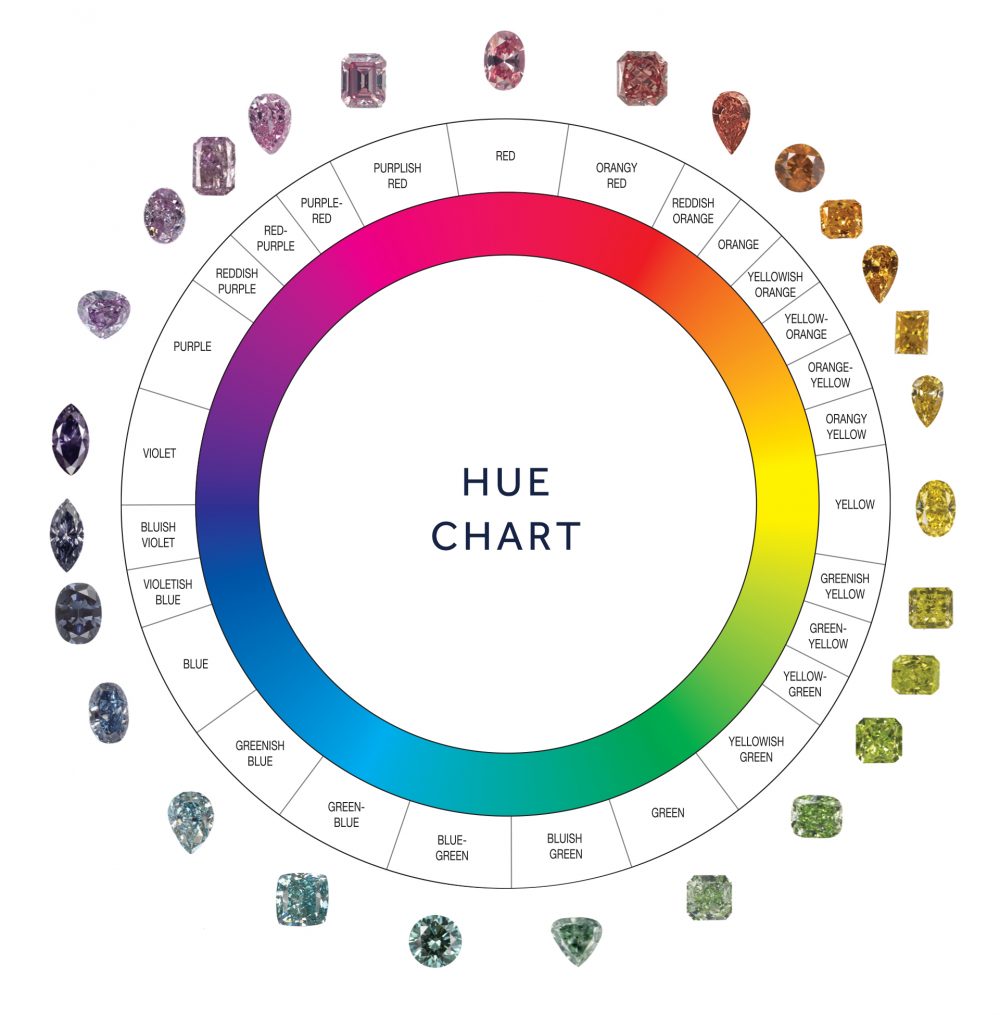
Read on for all the answers
Did you know that coloured diamonds are rare?
While all-natural colour diamonds are beautiful in their own ways, what makes them extraordinary is their extreme rarity. All of the world’s diamonds one carat and above recovered within one year would only fill one exercise ball. Natural fancy coloured diamonds comprised only 0.4% of all graded diamonds. This means that the number of pink diamonds recovered in a year would only fill a champagne flute. That was when the Argyle mine was operating, today the world pink supply is a heaped teaspoon. As The Natural Colour Diamond Association reports, only one natural blue diamond can be found on the market for every 100 Picasso paintings up at auction. These diamonds are indeed a remarkable gift of mother nature.
Coloured diamond rarity makes them extraordinary
Grading Report Terminology
Diamond colour graders at the Gemological Institute of America (GIA) have the tough job of making grade the calls – they evaluate each diamond for one of 27 named hues, with varying tones and saturation in controlled lighting boxes like that used to judge fabric colours. They are rarely considered to be consistent, but they are the best there is in an imperfect world. The science of colour is discussed at the end of this page. You must use three descriptors to describe colours: Hue, Tone and Saturation.
Fancy yellow diamond grades issued by labs start at Fancy Light, Fancy, Fancy Intense, Fancy Dark, Fancy Deep, Fancy Vivid. Very rare colours in diamonds (like pink, blue and green) can receive these 3 lower grades: Faint, Very Light and Light – because there is a market for them and they fetch high prices.

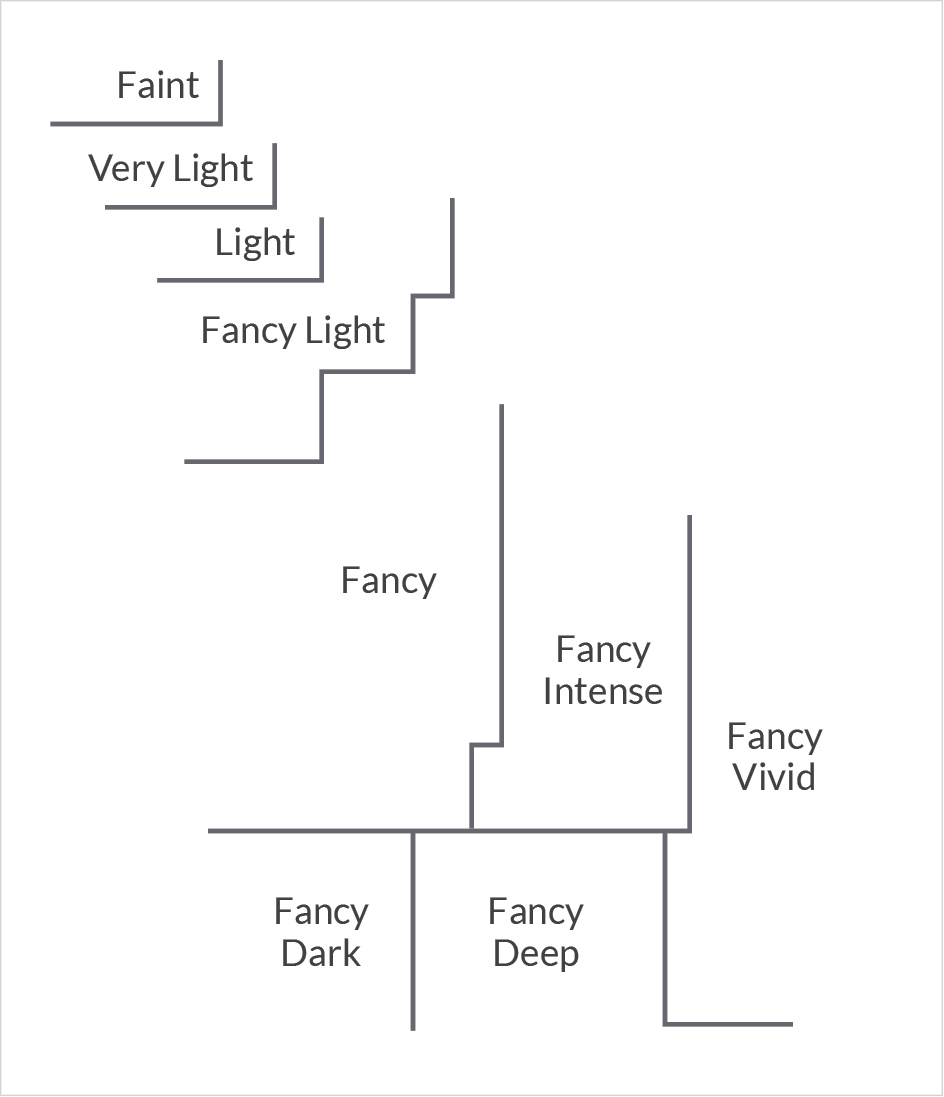
What causes Colour in Diamonds?
Diamond is a very pure carbon that is crystalised under immense heat and pressure more than 100km beneath the earth’s surface. Sometimes other atoms are trapped in a diamond as it grows. Nitrogen is by far the most common; the tiniest amount can cause blue light to be absorbed giving the diamond a yellowish tint. They have been shot to the surface within hours by a volcano that picked the diamonds up along the way. They are ‘snap frozen’ – but if the journey takes too long, or is a stop-start affair, they can be dissolved or graphitized. Australia Argyle diamonds often show evidence of crystalline stress under magnification with polarized light and this is the likely cause of color as most are very pure carbon. The rare pink Argyle colour is thought to be caused by a tiny amount of hydrogen atoms caught up in deformities in the atomic structure.
CHAMPAGNE DIAMONDS
The Argyle diamond mine does not produce yellow diamonds. All Argyle champagne and cognac diamonds are in a brown, not yellow series. They are a less expensive alternative FCD and were running at around a half to a third of the price of colourless diamonds before the mine closed. All Argyle diamonds fluoresce blue which gives them a great additional brightness in our Aussie daylight. Like pink Argyle diamonds, they too are now rarer and values are increasing. Most other brown diamonds come from Russia and are an unattractive olive green hue and many are non fluorescent.
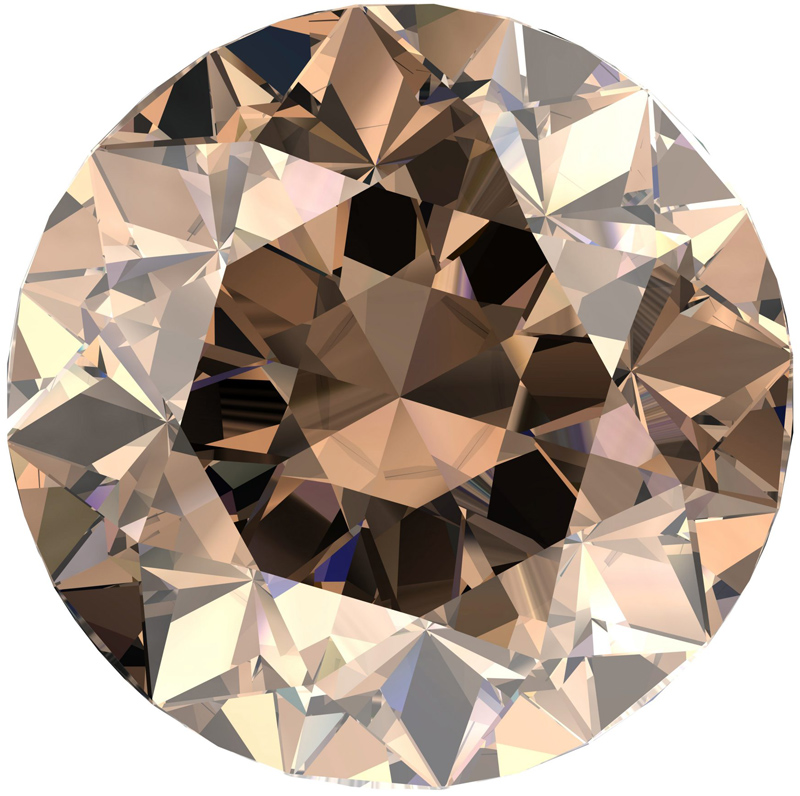
WHITE MILKY DIAMONDS
A little known and relatively rare are white opalescent diamonds. They are a lot less expensive than transparent colourless diamonds, but a lot of fun and can be a collector’s bargain. Gems and Gemmology, and GIA do give them a fancy colour grade. GIA’s journal, Gems & Gemology, has written papers about white diamonds. Who knows, they may become the next fashion thing, like black diamonds.
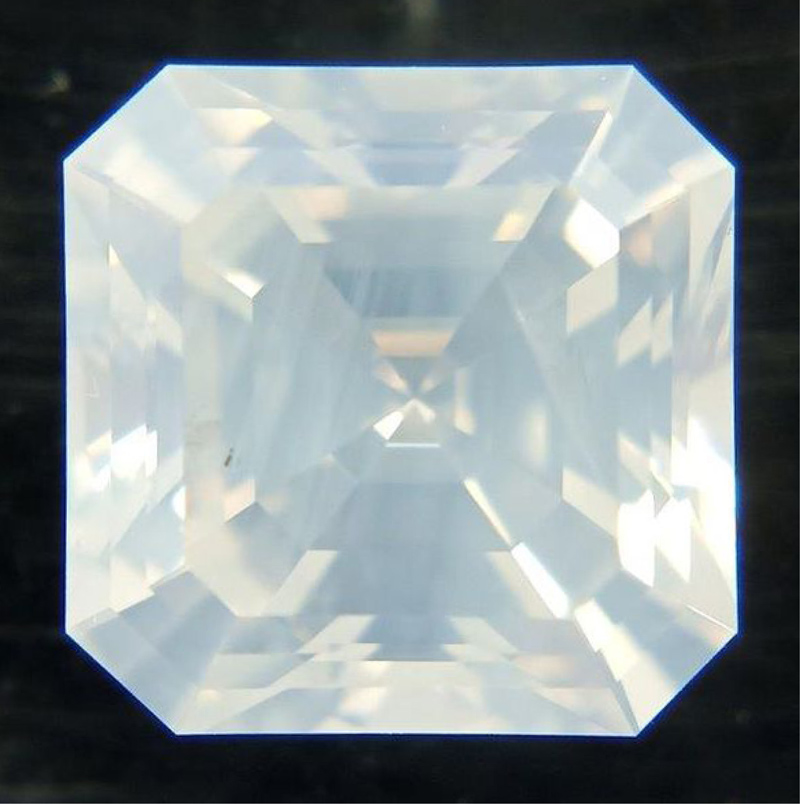
BLACK DIAMONDS
Most large black diamonds are very low clarity diamonds and have been heated in a vacuum to make all the inclusions go black. Natural untreated black diamonds have been heated in the earth and can be indistinguishable from stones that have been heated by man. The good surface luster of naturally or treated graphitised black is rare as by definition they have cracks that have allowed internal inclusions to graphitise. Natural or heated black diamonds with visible surface reaching feathers or cracks are relatively fragile. Black diamonds are often set into men’s jewellery and that often means breakages as men tend to be rougher with their jewels.
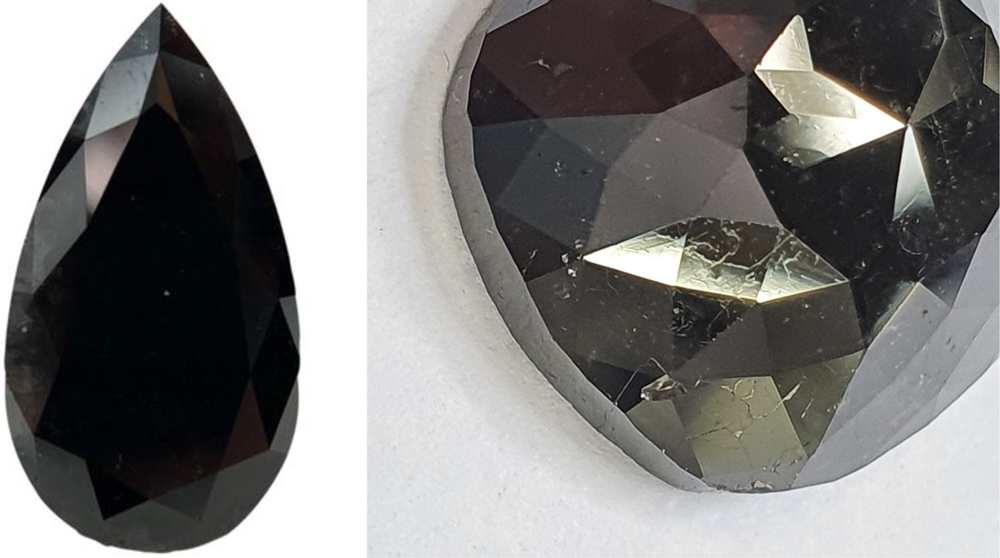
YELLOW DIAMONDS
This comparative price chart gives an approximation of relative prices for various hues (left to right) and saturation and tones (up and down). The grade names are those used by GIA.
The relative spreads and the impact of brownish hues also play a big role in pricing. Diamonds considered lighter than Fancy Light Yellow by GIA are graded on the D to Z scale.
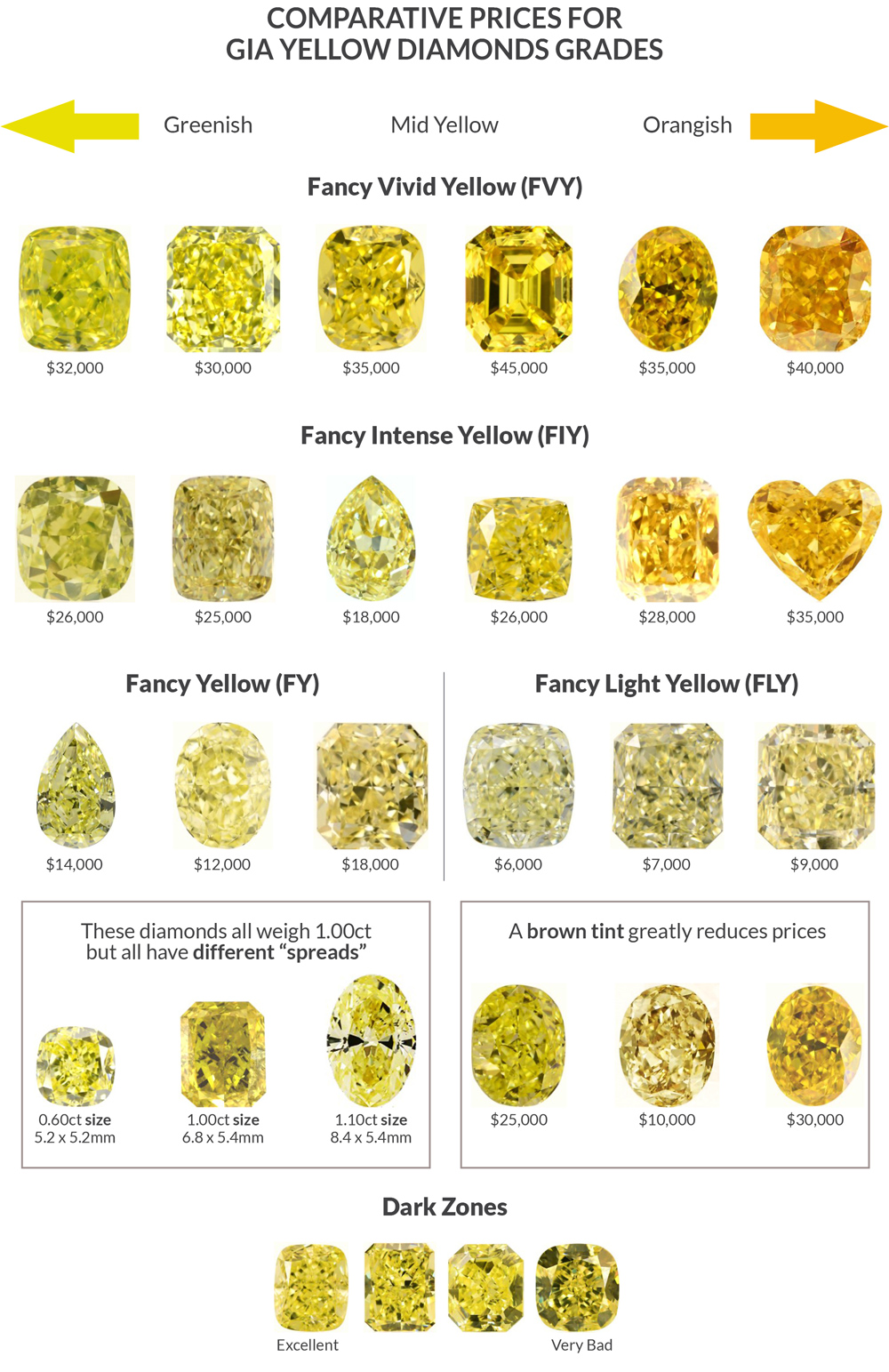
PINK DIAMONDS
This comparative pink diamond price chart below gives an approximation of relative prices for various hues (left to right) and saturation and tones (up and down). The grade names are those used by GIA. In the chart further down are the grades developed by Argyle because they deemed the GIA system as inadequate for the huge variety of diamonds from the Argyle mine.
The relative spreads and the impact of brownish hues also play a big role in pricing except when a diamond is considered to be brownish red. Red diamonds are the rarest pink diamonds and the most expensive, so a brownish red may well be more expensive than a more attractive pure pink diamond. If you can imagine a darker but slightly more brownish diamond than the radiant in the top right of the Holloway Diamonds chart, that could well be twice the price of the baby pink $1m oval! Unlike yellow diamonds, which are not as rare, and Fancy Light Yellow is the lowest Fancy grade, GIA has four additional pink grades that are on the D to Z scale.
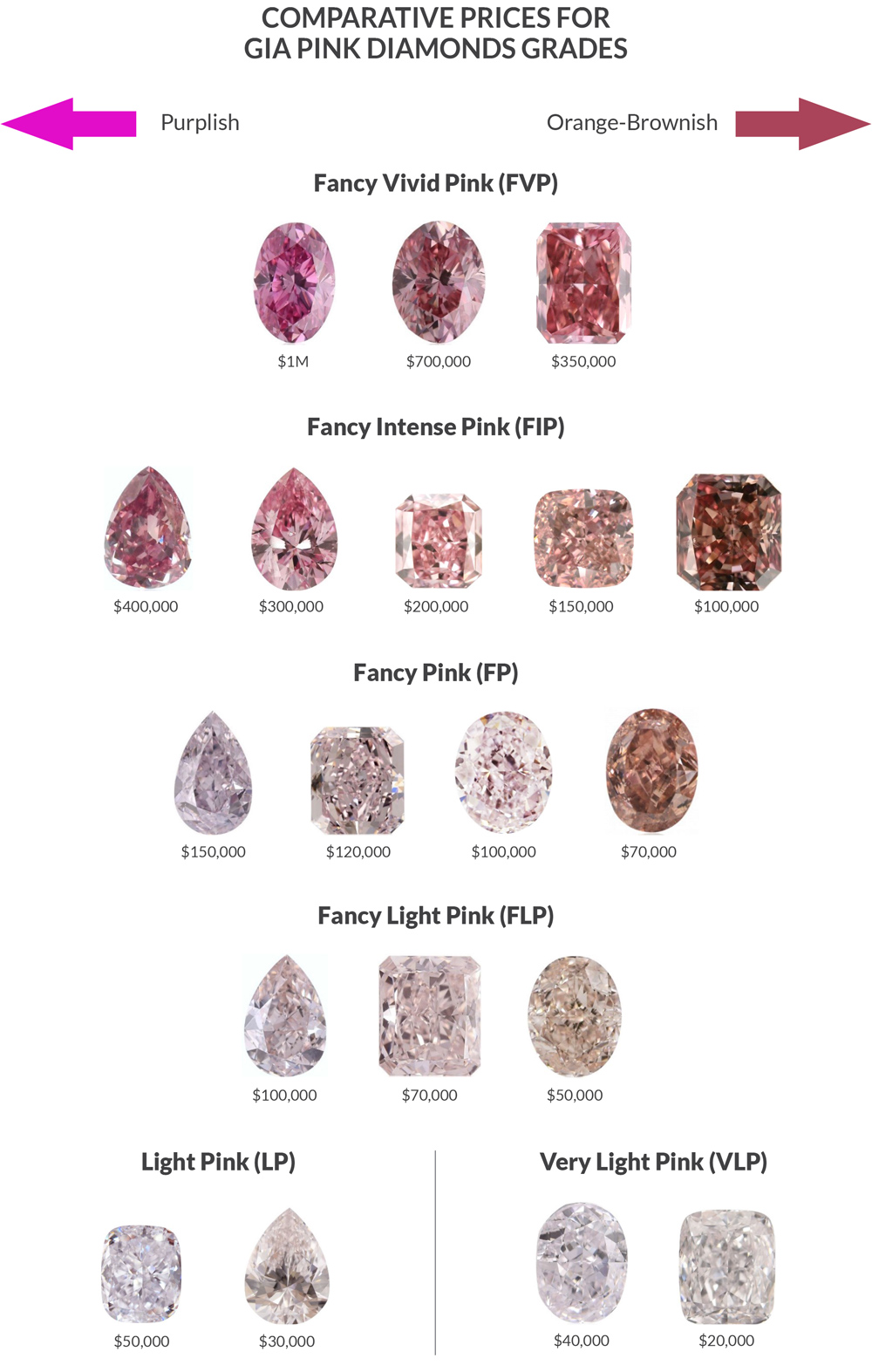

BLUE DIAMONDS
Blue diamonds make headlines because they tend to grow in very large crystals, so +5 carat is not uncommon. They are Type IIb, which means they are very pure carbon with a tiny impurity of Boron. The boron makes them electrically conductive and blue. The Argyle diamond mine also produced a small amount of blue diamonds which are not type IIb and do not conduct electricity. So they can be distinguished from non Argyle blues with a multimeter. A case of IIb or not IIb!
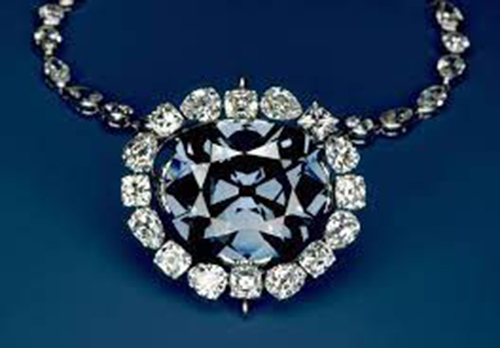
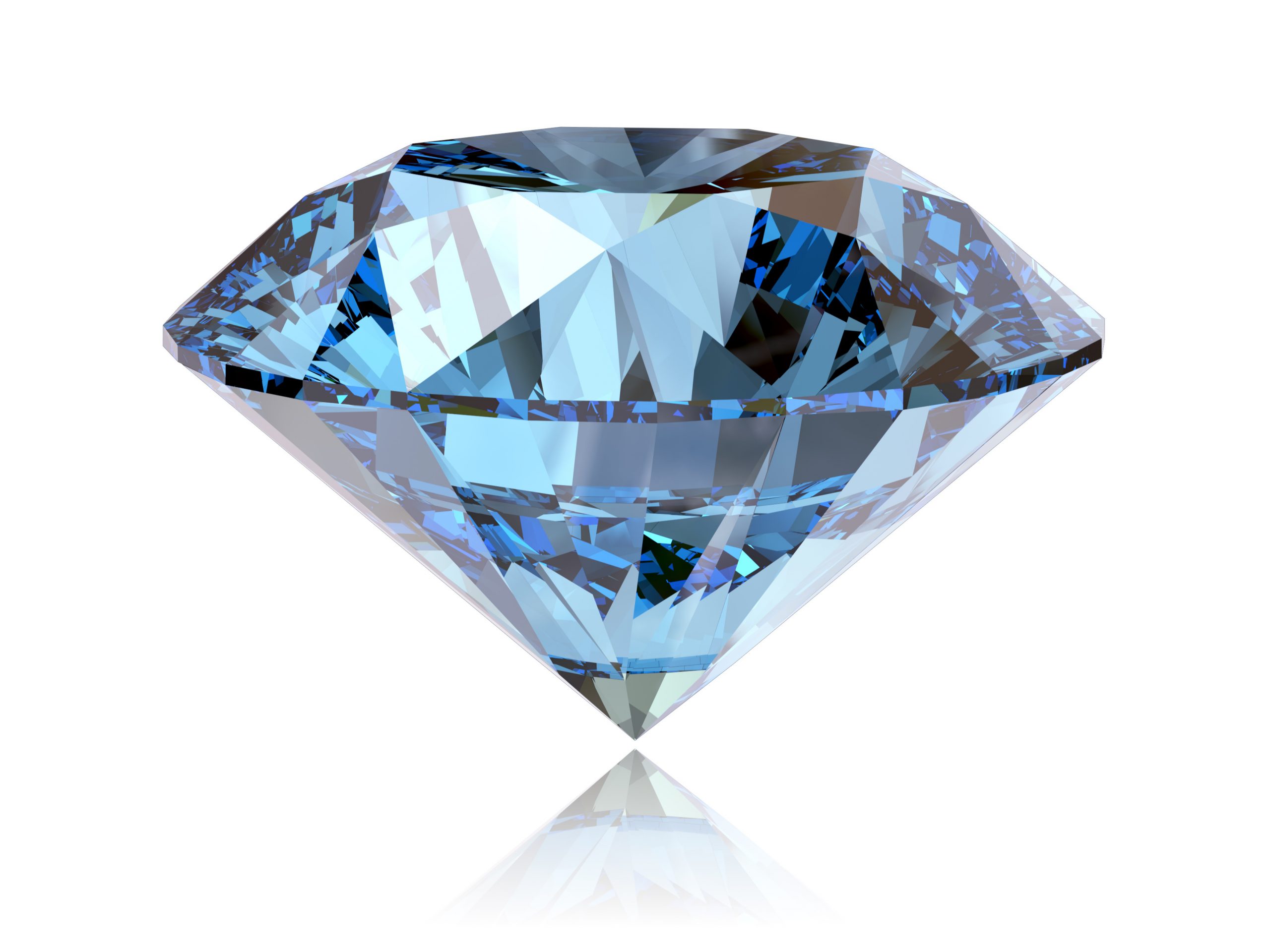
GREEN DIAMONDS
Green diamonds have nothing to do with other impurities. Their colour is formed by nearby natural radioactive materials knocking carbon atoms out of their crystal lattice position, causing the stone to reflect green light.
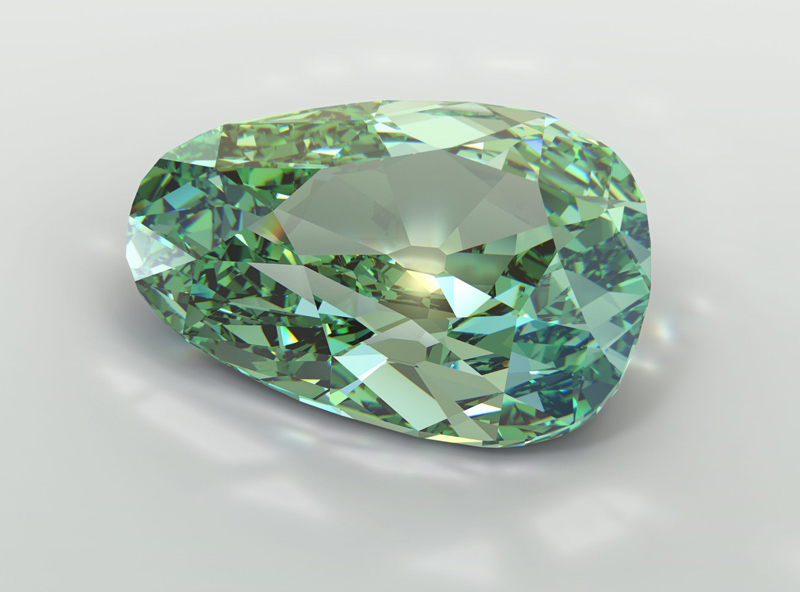
Dark Zones
One big problem with FCD’s is ugly dark zones that result from poor cut planning. Dark zones result from either the absence of light or from excessive leakage as in the case of the heart shape shown here. The table region would be dark after setting in jewellery. All these diamonds were GIA graded and listed as having ‘Even’ colour because GIA only considers colourless or dark zones of more than 50% of a diamonds face up view as constituting colour unevenness. The persistence of dark zones through a range of motions should also be taken into account when considering purchasing FCD’s.
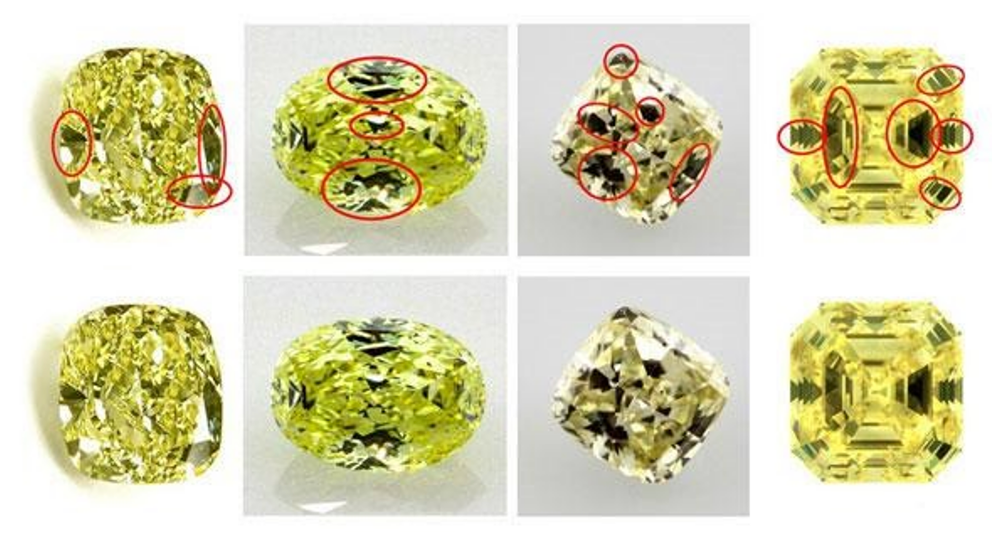

Cutting Fancy Shaped Diamonds
The science of cutting FCD’s is very different from cutting colourless diamonds where fast changing contrast from dark zones to bright is what makes them sparkly and brilliant – the alternating bright dark bright flashes as you rock a white diamond. If a diamond has a dark zone in a photo then it probably will in real life too, and light leakage zones may not appear dark until the diamond is set.
Getting rid of dark zones also increases the depth of saturation of colours in a diamond. Apart from brown diamonds, almost all other colours are very pale and the more saturated and deeper tone the cutter can produce the more beautiful and more valuable the diamond will be. In the image, there is an example of the same carat weight and colour virtual diamonds showing how advanced cutting colour has become.
Setting Fancy Shaped Diamonds
Most fancy coloured diamonds have reduced light return in order to capture light and enhance colour. As a result, it is a good idea when setting FCD’s as feature or center stones, to use cuts of diamonds with reduced brilliance. Cuts like half-moons, trapezoids, pear shapes and trillion cuts work well. If setting with well proportioned round diamonds, lowering the support stones, and tilting them away can help keep the hero as a hero.
Another trick is to place a reflective cup under the diamond; yellow gold for yellow diamonds and rose gold for pink diamonds. This does make it more difficult to clean the diamond, so there must be some holes to enable steam cleaning using an espresso coffee milk steamer or purchasing a purpose-built steam cleaner.
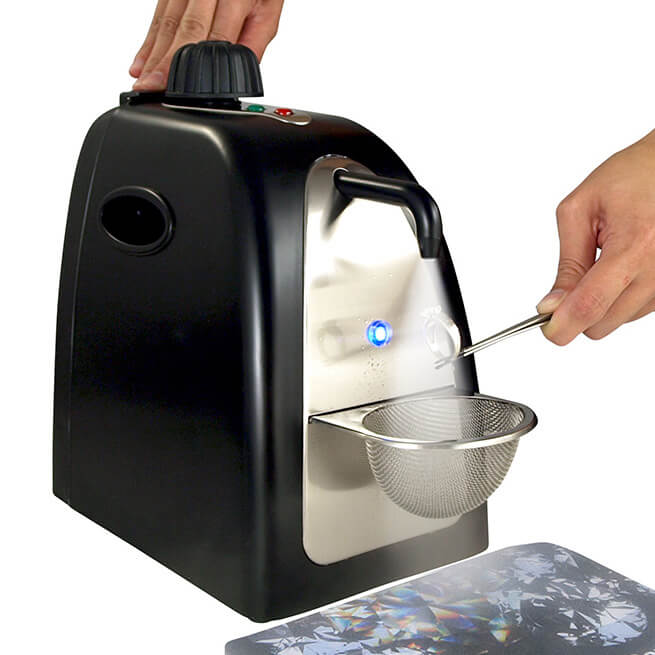
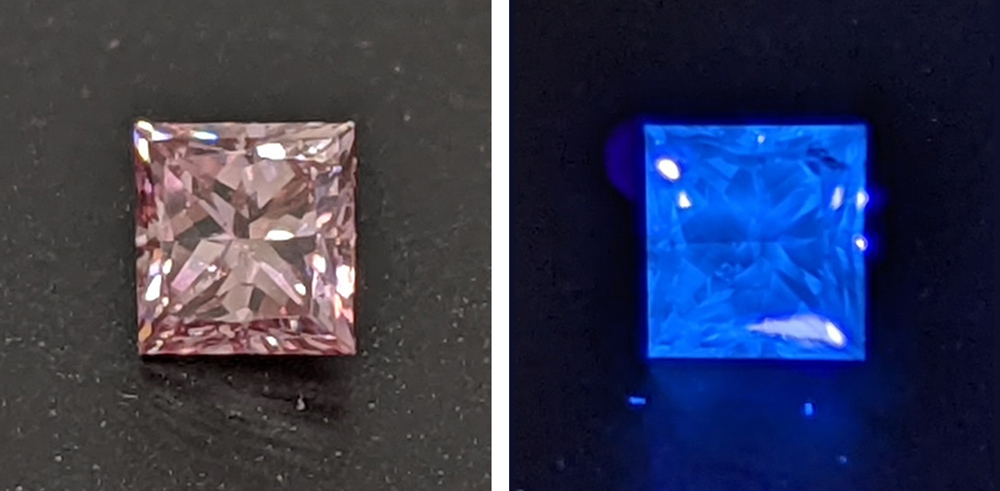
Fluorescence and Complimentary Colours
In simple terms, colours directly opposite each other on the colour wheel are said to be ‘complimentary colours’. When a diamond fluoresces with its complimentary colour it will appear less saturated when seen in daylight.
Blue and yellow are complimentary colours; red and cyan are complementary; and so are green and magenta.
Mixing two complimentary colours of light together gives you white or grey. Blue fluorescence can make a yellow diamond paler or less saturated and reduce its value. Yellow diamonds that fluoresce yellow will be a stronger yellow in daylight which has more UV light. Green diamonds that fluoresce yellow are highly sought after, they seem to have a radioactive glow. Unfortunately, yellow diamonds more commonly fluoresce blue and are sold at a lower price.
All or almost all pink, champagne and colourless Argyle diamonds, are strongly blue fluorescent. This is an advantage in the case of pink diamonds because purplish pink diamonds are more valuable than straight pink. Fluorescent brown or champagne diamonds become a shade lighter in daylight.
Fancy Coloured Diamond Values
People invest in FCD’s because of their rarity.
Firstly, the market is more volatile and secondly, there is a lot of information that may not be relevant to you or your situation. For example, the chart here is put together by the Natural Colored Diamond Association or NCDA, an association of leading dealers. Their focus is on very high-value +5 carat diamonds mainly sold at international auctions as this overcomes the biggest issue in the industry: price transparency. An example of the limitations of this method of pricing is that pink diamond prices appear to have been stable and static for several years. Nothing could be further from the truth in the case of Argyle pink diamonds which make up by far the largest segment, but with the least pricing information.
Argyle never produced a +5ct pink diamond, but as the world’s supplier of +95% of intense pink diamonds smaller than 0.10ct are able to be matched in sets and used in jewellery – these sets are now in high demand and prices have gone up more than five fold in the past five years!

FCRF Fancy Color Diamond Index.
Image Source: Fancy Color Research Foundation – FCRF, www.fcresearh.org
Carat weight has a similar impact on pricing the same as colourless diamonds. Arguably, snob carat weights, like 1ct, 5ct, have more impact on collectible diamonds as buyers are often focused on the potential resale value. Fancy yellow diamonds are found with similar size distributions to colourless diamonds, but natural blue diamonds are very pure type II with a minuscule amount of boron that causes the color. Type II diamonds are often found in very large sizes and so there are quite a few very large blue rough diamonds found each year. (Argyle grey-blue diamonds are an exception and are mostly very small.)
Clarity, as mentioned elsewhere has less impact on pricing than colourless diamonds.
The owner who submits a FCD to GIA can request a ‘partial cert’, which does not mention the clarity grade (and some other factors). Buyers usually take this to mean the stone has a clarity of I1 or lower. In some cases, the vendor may communicate the diamond has an I1 grade while buyers might argue the diamond is an I2. There are many million-dollar FCD’s with grades as low as I2, but very few GIA full cert graded I2 or I3 diamonds!
A ‘half cert’ is proof that GIA considers the diamond to be natural and the colour is untreated. A lot of other very important information is also missing, and this allows diamond cutters to get away with blue murder. It makes sense that a seller would not want to declare that a diamond has an imperfect grade, given that many low clarity rare coloured diamonds fetch 7 figures. Buyers should beware that a half cert does not include polish and symmetry grades which are often very poor. There are no cut quality grades for even round diamonds and across the board cut quality is notoriously bad. Fluorescence is not mentioned and can cause a marked reduction in apparent colour.
The ‘double certed’ diamond in the table is the very first larger than one carat vivid pink diamond ever mined at Argyle. The diamond is from samples at Smoke Creek taken to prove the economic viability before Argyle was even named (after nearby Lake Argyle). I purchased it from Bill Leslie, who at the time was a company lawyer and a director of Ashton Mining who discovered the mine.
Colour unsurprisingly is the all important value factor. Consider that there are 17 grades for D-Z colourless diamonds where as for yellow diamonds there are only six and pink, blue, orange and green there are nine. This means the price jumps at grade boundaries can be very large, more than double in extreme cases.
Colour accuracy from photos
Interpreting how diamonds really look from a photo, even if the same vendor took them, is tricky. Images from different vendors make it impossible. In this example, the first three photos may be consistent because the same setup has been used from the same vendor (though the background variances could mean they were photoshopped). The pear shape is dulled by inclusions. The fourth image is less flattering but probably more realistic. It’s from a manufacturer from whom we buy hundreds of diamonds a year, and we know their photos match their stones. In the case of that diamond, strong blue fluorescence is a huge benefit.
A fourth factor is modifying secondary colours mentioned above. Both Argyle and GIA have crazy unpredictable variances in their grades which are evident when you see the diamonds side by side, as shown in the example.

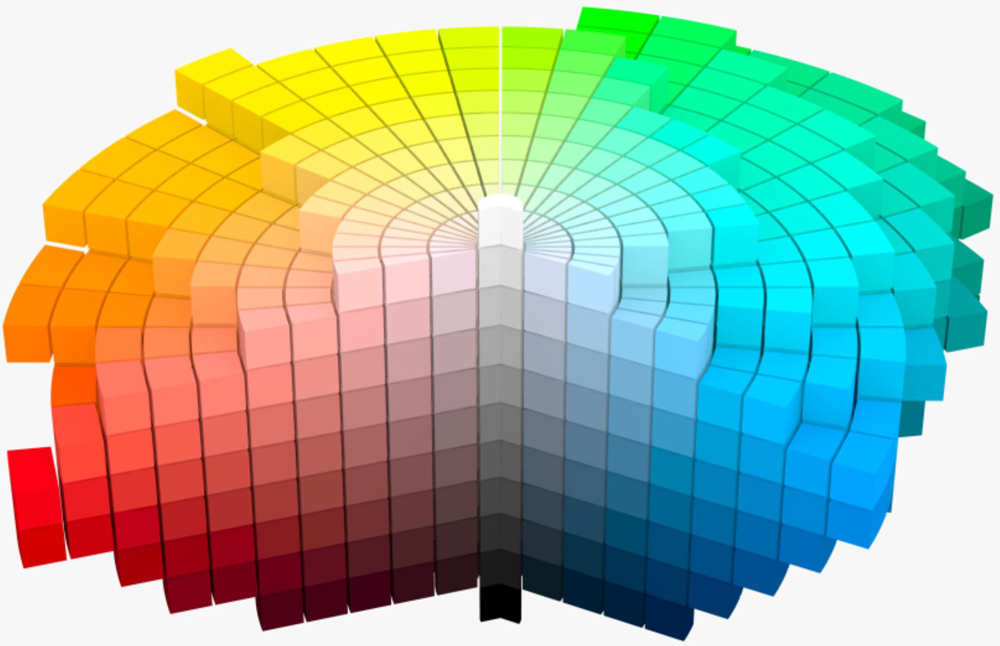
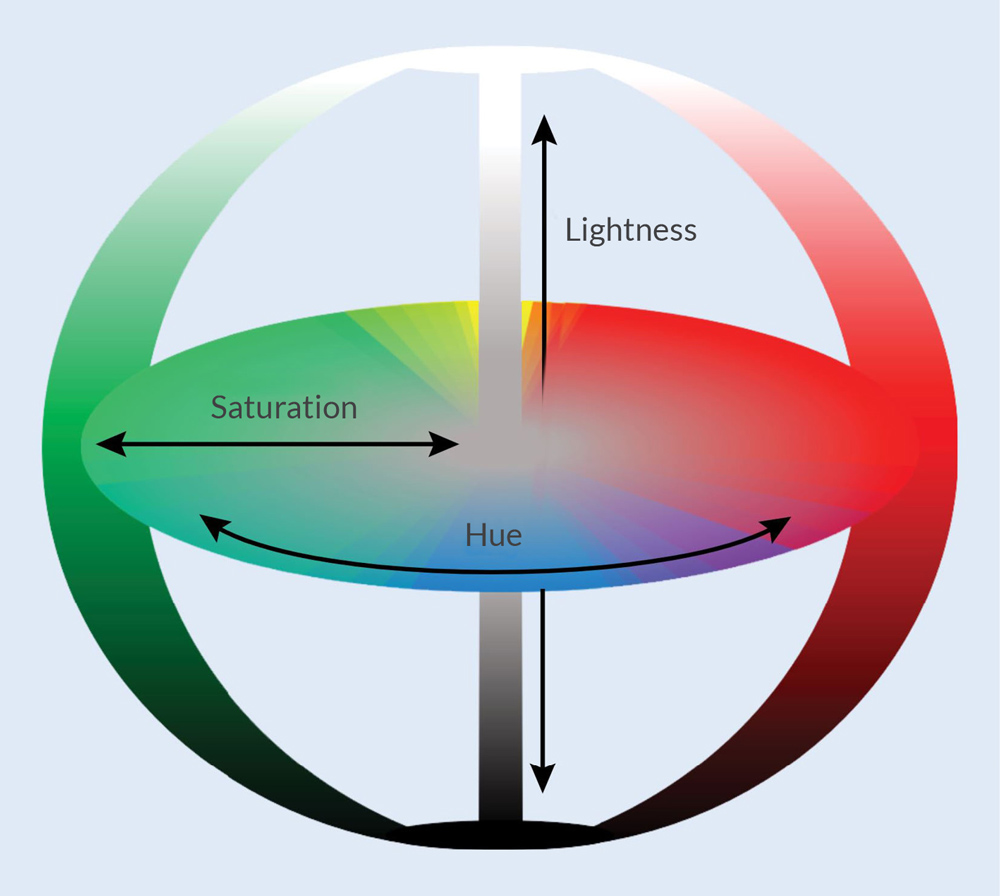
Colour Science
Colour can best be described as three-dimensional, it is very complex. Most people try to describe colour by the hue and the light or darkness, however, you must also describe the saturation or bright to dullness.
The Munsell colour wheel shows how Hue, Tone, and Saturation work together.
A good analogy for understanding colour is to consider an imaginary concept of traveling through the centre of the earth in an elevator with windows all around. In the center of the earth, we look out and see all the Hues around the ‘equator’ – all the colours of the rainbow with violet joining up nicely with the plum colour. As we go up things get lighter, and if the elevator descends all the way to the south pole all we see is blackness. That is tone; lightness to darkness. If we go back to the center of the earth and step out onto that floor, walk out towards the red direction, the saturation of the red gets more intense. If we look up to the floors above we see pink, and down we see burgundy. When we arrive at the equator, we see vivid red. Looking to our right, we see really bright orangish red and to our left things turn plum coloured.
To make things a little more complex, the equator is not a circle. For example, red and green colours can be more saturated than blue and yellow. Then there are secondary colours or hues that impact attractiveness. Warmer colours on the red to the green side of the ‘colour world’ can have a brownish duller undertone and the blue cooler side can be greyish. Sadly, blue diamonds all suffer from a bit of greyness and are never quite as richly saturated as the finest sapphires.
A yellow diamond with a green secondary hue is graded as “Fancy Greenish Yellow.” A yellow diamond with a darkish tone might be called “Fancy Brownish Yellow” or if it is duller still, it may be graded as “Fancy Yellowish Brown” and suffer an even bigger price drop. Secondary hues in yellow diamonds include orangish greenish yellow (often slightly cheaper) and orangish yellow (can be more expensive – pure orange is exceptionally rare and very costly).
